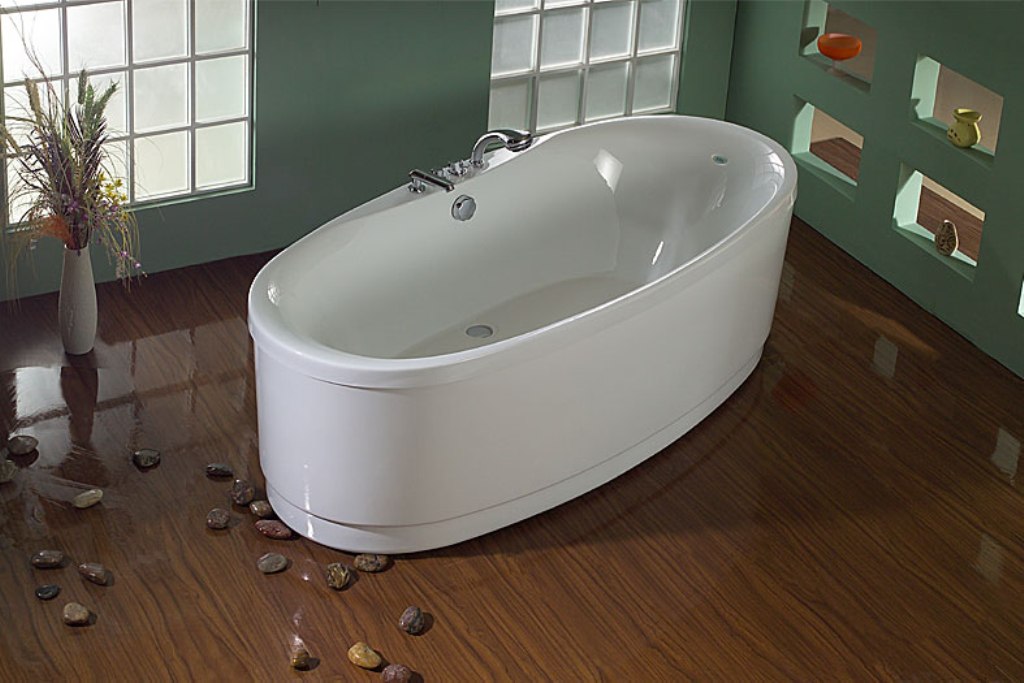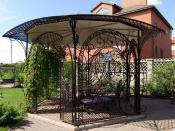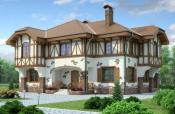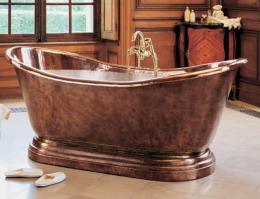Search
Login
Choose a bath
We will carry out a comparative analysis of cast iron, steel, acrylic, kvarilovyh, bathtubs made of artificial and natural stone. Perhaps this will help you choose the right model.
Content
- Bath base material video
- Size and shape matter
- Healing procedures
- Bath Installation Methods
- Security
- Bath care
- Bath Repair video
Bath base material
Thinking about purchasing a bath, many buyers are faced with the question of choosing the material from which the bath is made.
The property of the bath - weight, strength, resistance to pollution, the ability to repair, directly depend on the basis of the bath.
The choice of options for these products is currently very large, dwell on some types of bathtubs.
cast iron bath
It is widely used in our country and this is justified by the fact that cast iron is a durable material, resistant to corrosion, and not subject to deformation.
The bath is cast in a special form, coated with technical enamel, and then decorative enamel.
Due to the non-ductile properties of the material, rectangular and oval bathtubs are made of cast iron.
The main disadvantage is the huge weight, because of this it is difficult to carry and mount.
Cast iron has a high inertia (warms up for a long time and cools for a long time), has thick walls that muffle the sound of pouring water.
In today's market there is a large selection of such products.
steel baths
These bathtubs are cheaper than cast iron, they are molded from solid steel sheet, then enameled.
This material is more plastic, which is why bathtubs of more complex shapes are produced.

These bathtubs are much lighter than cast-iron, but when purchasing, pay attention to the bottom, it should not be too thin.
The disadvantages include less stability (they may roll over), they retain heat worse, and when the bathtub is filled with water, a strong rumble is heard.
acrylic bath
This modern material is gradually replacing its metal counterparts.
Acrylic bathtubs have many advantages, namely: they retain heat for a long time, acrylic is not as slippery as enamel, these bathtubs do not rattle when filled with water, it is lighter than metal and cast-iron.

Acrylic baths do not change color, do not turn yellow, since acrylic is easily painted, you can purchase a bath of any color.
An important role in the manufacture of an acrylic bath is played by the quality of the material, good acrylic must have a high density, a layer of acrylic should be a few millimeters.
oil bath
The name reflects its main components.
Such bathtubs are cast from a mixture of quartz powder and liquid acrylic.
This material has incorporated the best properties of acrylic and artificial stone.

He cooked smooth and warm, less porous, but very durable.
Quiril models are homogeneous, more resistant to damage and deformation, the surface can be easily restored.
These bathtubs are less slippery and lighter.
Bathtubs are available in various colors and shapes.
artificial stone bath
Such baths are also called cast marble, as they are made of marble or granite chips and polyester resin.

These models have high strength, are resistant to damage, lighter than cast iron, but heavier than acrylic, retain heat well and do not make noise when filled with water.
These models do not change color, the surface is dense and easy to clean.
The disadvantages include the more expensive cost and heavy restoration in case of damage.
stone bath
These are luxurious, but very expensive models, their cost is ten times higher than acrylic, cast iron or steel.
To expensive exotics, you can also include baths:

from copper;

a tree;

glass.
Size and shape matter
Currently, with a highly developed construction, the bathroom comes in a wide variety of dimensions and layouts.
Accordingly, the baths themselves have different shapes and sizes.

The most common are rectangular and oval models, they can be placed both along the wall and in the middle of the room.

Different types of corner bathtubs allow more efficient use of the bathroom space.

A huge number of asymmetric bathtubs is produced, narrowed at one end, this allows you to save space, more conveniently arrange furniture and appliances.
The main part of the baths has a length of 170 to 200 cm, a width of 70 cm.
There are also shortened sitz baths, most often these are cast-iron and steel models.
Available models of bathtubs have various forms of the inside, a variety of niches and seats, often have head restraints.
Healing procedures
Modern bath models have a wide range of functions. The most popular of them are hydromassage and air massage.
During hydromassage, part of the water is taken from the bowl and then water jets are fired through special nozzles in the walls, thereby exerting a massaging effect.

The number of nozzles from 4 to 8 or more.
Air massage is also done with the help of special nozzles through which air bubbles are fed into the water, rising up they gently massage the body, relaxing it.
Both of these bathtubs are usually made of acrylic.
Of the useful functions of baths, ozonation can be noted, where the bath saturates the water with ozone, which disinfects the water and the surface of the bath, thereby healing the human skin.
The function of chromotherapy (color effect) improves mood, psychological and physical condition.
Bath Installation Methods
The bath can be installed as a self-supporting structure, on its own supports.
These are the most popular models on the market, as they are easy to install, can be installed against the wall, or can be in the middle of the room.

The built-in bathtub is mounted on a special supporting frame, it will securely fix it in space.
Often bathtubs are decorated with panels around the perimeter of the bathtub.
Panels are often made removable, this allows you to use the space under the bathroom.
Security
It should be noted that the slippery surface of the bath can lead to a fall, especially of older people and children.

Now much attention is paid to safety, many models of bathtubs with handrails are produced, the problem of slippery surfaces is solved with the help of special notches at the bottom of the bathtub, or relief non-slip coatings.
Bath care
The bath must be rinsed after each use, as fresh dirt is easily removed simply with water or a soapy solution.
Important! Abrasive detergents can seriously scratch the enamel coating of cast iron and steel models, as well as acrylic surfaces and artificial stone surfaces.
Important! Cast iron and steel baths must not be cleaned with products containing acid.
Hot tubs and aero massage bathtubs are equipped with an automatic cleansing function.
Bath Repair
Cast iron and steel baths, if enamel is broken, can be restored by gluing an acrylic liner.

Acrylic and qvar are easily repaired, for this purpose special compounds are produced, with their help they fill in scratches and all problems are solved.





